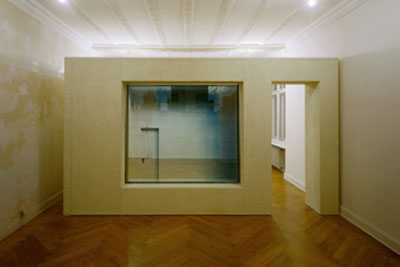 Sabine Hornig Balkon Click here for English text Ein Balkon ist als Skulptur in die Galerie eingebaut. Er ist an seiner Schmalseite befestigt und ragt längs in den Galerieraum hinein. Eine Sperre quer im Raum. Man kann an ihm entlang- und herumgehen und über ihn hinweg wieder aus dem Fenster sehen. Fotografien von Fenstern, die Blicke in Innenräume zeigen, korrespondieren in der Ausstellung mit der Skulptur des Balkons. Sabine Hornig baut in ihren Installationen vorgefundene oder Prototypen von Architekturen nach. Die Skulptur "Balkon" vermittelt das Bild eines typischen Balkons, wie er an einem funktionalen Bau der Moderne oder an einem Berliner Plattenbau gefunden werden könnte. Er ist losgelöst von seinem angestammten Ort, dem Außenraum, versetzt in den Innenraum. Überzogen ist der Balkon mit Rauputz, was ihn neben seiner vollkommen schnörkellosen, unpersönlichen Bauweise zusätzlich stereotypisisiert, ihn als ein typisches Element urbaner Architektur ausweist. Ein Handtuch ist lakonisch über die Brüstung des Balkons gehängt. Der Balkon als nach Außen fortgesetzter Innenbereich trägt Privatheit in die Öffentlichkeit. Er ist Freizeitidyll und Beobachtungsposten. Von Balkonen aus werden Republiken ausgerufen. Und so wie im Repräsentationsbau der Balkon Plattform für Herrscher ist, die dem Volk durch ihr Heraustreten aus den schützenden Bauten einen Blick gewähren, ist er im Gegenzug der Ort, von dem das Volk aus den Vorbeiparadierenden zu huldigen hatte. In der Ausstellung wird das Wechselspiel zwischen Innen- und Außenraum verstärkt durch mehrere Fotografien, die Fenster zeigen. In den komplexen Bildkompositionen verschränken sich wiederum die Ebenen: Zwar gewährt der Blick durch das Fenster eine Sicht in den Innenraum, diese wird jedoch gebrochen durch die Reflexion des Außenraums, des unmittelbaren Gegenübers, das sich in der Scheibe spiegelt. So werden die Wände der Galerie zur Außenfassade, auf der die Fotografie als Bild ein Fenster in einen anderen Bereich öffnet. Das reale Fenster im Galerieraum lädt die räumliche Verschränkung in den Fotografien zusätzlich auf. Skulptur wie Fotografie erlauben durch die Übertragung von Gebautem in ein anderes Medium deren Wahrnehmung als Stellvertreter einer Architektur des Alltäglichen, Unspektakulären, die wesentliche Teile des zeitgenössischen Stadtbildes prägt. Die eigentlichen Elemente, die Stadtarchitektur definieren und klar einem bestimmten Funktionsbereich zuweisen, werden hier zur Disposition gestellt. Die Ausstellung findet statt im Rahmen des Projektes "Rethinking: Time, Space and Architecture" anlässlich des XXI. World Congress of Architecture in Berlin. Zum Projekt erscheint ein Katalog. Ausstellungsdauer: 1.6. - 31.8.2002 (verlängert) Oeffnungszeiten: Di-Fr 13 - 19 Uhr, Sa 13 - 18 Uhr Galerie Barbara Thumm Dircksenstrasse 41 D-10178 Berlin Telefon +49 30 283 90 347, Fax +49 30 283 90 457 E-Mail b.thumm@berlin.snafu.de www.bthumm.de Sabine Hornig Balcony A balcony is installed like a sculpture in the gallery space. The balcony is attached with its narrow side to the wall and juts out into the gallery - a barrier across the space. One can walk alongside and around the balcony and look over it out the gallery's window. Photographs of windows showing interior spaces correspond in this exhibition with the sculpture. Sabine Hornig's installations are based on existing structures or prototypes of architecture. The sculpture "Balcony" represents a typical balcony as it can be seen on any modernist building or Berlin "Plattenbau". It is detached from its original setting, the exterior, transfered into the interior. The balcony is covered with stucco, which - besides the clean, impersonal architecture - adds to its stereotypical features, characterizing the balcony as a standard element of urban architecture. A towel casually hangs over the balustrade. A balcony as a space within a home projecting out into the exterior takes privacy into public. It is a holiday idyll and an observation point. Republics are proclaimed from balconies. And as much as the balcony is in representational architecture the platform for the reigning and for politicians who step out to make a public appearance, it is also the place from where the public in return had to pay hommage to those on parade. The interaction between interior and exterior within the exhibition is intensified by a series of photographs showing windows. In these complex compositions again different levels link: Although the window allows a view into an interior, this view is distorted by the reflection of the exterior, the opposite space, that is mirrored in the glass. Thus the gallery's walls turn into an outside facade on which the photographic image opens a window into another space. The gallery's real window further increases the spatial complexity of the photographs. The sculpture as much as the photographs allow due to the transfer of a built structure into another medium their perception as representatives of an architecture of every-day life, of the unspectacular, that marks major parts of contemporary urban space. The decisive elements that define a city's architecture and that clearly distinguish its various functions are offered for analysis. The exhibition takes place within the context of the project "Rethinking: Time, Space and Architecture" on the occasion of the XXI. World Congress of Architecture in Berlin. The project will be accompanied by a catalogue. |